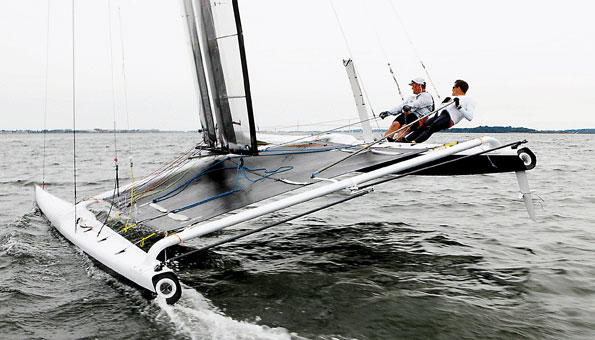Californian Alex Kosloff was a pioneer of the US West Coast C-Class movement – and was one of the first to understand the trade-off between weight and efficiency… a balance that will soon be revisited in full technicolor on San Francisco Bay
Early west coast C-Class development
Back in the 1960s the British Amateur Yacht Research Society (AYRS) publications edited by John Morwood provided the rest of us spread around the globe with the most up-to-date information available on developments in multihull sailing craft. A number of us who were sailing Malibu Outriggers at the time became enamoured with the development opportunities offered by the then IYRU’s new C-Class cats. We avidly followed British sailor Reg White’s exploits with his little group, first with Emma Hamilton and later on using their magnificent wing-masted C-Class Lady Helmsman, as in succession they trounced two Australian and three east coast USA challengers for the International Catamaran Challenge Trophy – already better known as the Little America’s Cup.
Since 1961 the eastern USA C-Class enthusiasts had been building their boats out of wood, during which time they had competed unsuccessfully for the trophy three times; now we on the west coast decided it was our turn to have a go. But right from the start we knew that we would be building our boats in composite.
My good friend Bob Noble, a resident of Costa Mesa, CA (at the time the world’s FRP/GRP boatbuilding mecca), was responsible for building the first FRP C-Class hulls in 1968 to a design by Bob Reese – who had previously designed the wildly successful D-Class cat Wildwind (the same hull design was used for Dave Bradley’s Whiplash, Steve Dashew’s Beowulf IV, Lee Griswold’s Taku, Alex Kozloff’s Aquarius I and II and others).
It didn’t take us long to work out that in the smaller C-Class it was best to put the entire allowed 300ft2 of sail area into one sail. Most of us started out using standard mast sections with triangular mainsail profiles; however, it is notable Bradley and his crew, Gary Marlotte, were already using a square-topped sail on their D-Class that was decades ahead of its time. When the Danes finally broke the British stranglehold on the ICCT in 1969 with the FRP-hulled Opus III, Lee Griswold ordered a set of the beautiful Danish Opus hulls for a new Taku II; now there were two players on the west coast C-Class scene.
Even after closely monitoring C-Class development in Europe, at this stage (1970-72) we were still giving remarkably little thought to the weight of our early platforms; we were convinced that daggerboards and rig configurations were much more critical to performance. That would soon change...
We invite you to read on and find out for yourself why Seahorse is the most highly-rated source in the world for anyone who is serious about their racing.
To read on simply SIGN up NOW
Take advantage of our very best subscription offer or order a single copy of the June 2012 issue of Seahorse
Online at:
www.seahorse.co.uk/shop/index.php
Or for iPad simply download the Seahorse App at the iTunes store



